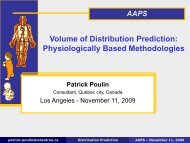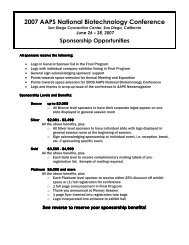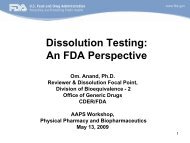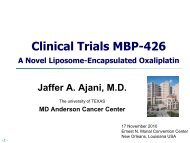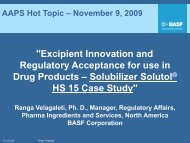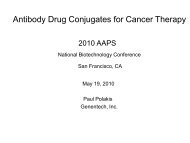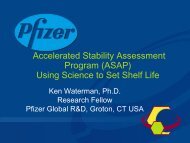Preliminary Program - American Association of Pharmaceutical ...
Preliminary Program - American Association of Pharmaceutical ...
Preliminary Program - American Association of Pharmaceutical ...
You also want an ePaper? Increase the reach of your titles
YUMPU automatically turns print PDFs into web optimized ePapers that Google loves.
69<br />
2009 AAPS Annual Meeting and Exposition<br />
AAPS Pharmacokinetics, Pharmacodynamics and Drug Metabolism (PPDM) <strong>Program</strong>ming<br />
2:00 pm – 4:30 pm<br />
Pros and Cons <strong>of</strong> Emerging Methods in<br />
Population PK and Exposure/Response<br />
Analysis<br />
Symposium<br />
This session will discuss the advantages and<br />
limitations <strong>of</strong> emerging and established algorithms<br />
and s<strong>of</strong>tware implementations <strong>of</strong> population<br />
PKPD analysis methods. The following algorithms<br />
(s<strong>of</strong>tware) will be discussed, with a focus on the<br />
versatility <strong>of</strong> the methods to specify and estimate<br />
complex PKPD models (such as mechanistic disease<br />
progression models, and models with categorical or<br />
time-to-event endpoints): SAEM (MONOLIX), MCMC<br />
(BUGS), and MCPEM (S-ADAPT), NLME (MATLAB<br />
and NONMEM).<br />
Moderator<br />
Amit Roy, Ph.D.<br />
Bristol-Myers Squibb<br />
Likelihood Estimation in Population<br />
PKPD Analyses Using the SAEM Algorithm<br />
Implemented in MONOLIX<br />
Radojka Savic, Ph.D.<br />
INSERM<br />
Modeling and Nonlinear Mixed-effects<br />
Methods in MATLAB and SimBiology<br />
Ricardo Paxson, M.S.<br />
The MathWorks, Inc.<br />
Pros and Cons <strong>of</strong> Bayesian PKPD Modeling<br />
Using BUGS<br />
William R. Gillespie, Ph.D.<br />
Metrum Research Group LLC<br />
Comparison <strong>of</strong> Population Estimation Methods<br />
for Complex PKPD Systems<br />
Chee Ng, Ph.D., Pharm.D.<br />
Bristol-Myers Squibb<br />
2:00 pm – 4:30 pm<br />
Leveraging Prior Quantitative Knowledge<br />
in Guiding Pediatric Drug Development<br />
Symposium<br />
The U.S. Food and Drug Administration and<br />
European Medicines Agency have recently renewed<br />
their call for innovative model-based approaches<br />
to pediatric drug development. It is evident in the<br />
requirements for sponsors to include a modeling<br />
and simulation plan, where applicable, in their<br />
pediatric investigational plans (PIP) and use <strong>of</strong><br />
clinical trial simulations to support pediatric written<br />
request. The key issues facing us today are high<br />
pediatric trial failure rate due to lack <strong>of</strong> powerful and<br />
innovative clinical trial designs, failure to establish<br />
informative pediatric dosing recommendations due<br />
to lack <strong>of</strong> appreciation for differences in exposureresponse<br />
relationship between pediatric and adult<br />
population. Traditionally, studies have focused on PK<br />
differences only. Inappropriate or lack <strong>of</strong> use <strong>of</strong> prior<br />
quantitative knowledge to better design pediatric<br />
development programs The objectives <strong>of</strong> this<br />
session are to demonstrate through case studies the<br />
value <strong>of</strong> designing pediatric developing programs<br />
using model-based approaches, and demonstrate<br />
through case studies the impact <strong>of</strong> prior quantitative<br />
knowledge on pediatric development/dosing<br />
decisions. This symposium has been aligned with<br />
the symposium, entitled “Strategic Biomarkers for<br />
Treating Diseases in Younger Children Safely and<br />
Effectively” scheduled for Monday, November 9,<br />
2009 at 2:00 pm. The goal <strong>of</strong> this alignment is to<br />
give the attendees a complete overview <strong>of</strong> pediatric<br />
drug development.<br />
Moderator<br />
Pravin Jadhav, Ph.D.<br />
U.S. Food and Drug Administration<br />
Transforming Pediatric Drug Development by<br />
Informed Decision Making<br />
Pravin Jadhav, Ph.D., invited<br />
U.S. Food and Drug Administration<br />
Role <strong>of</strong> Modeling and Simulation in<br />
Developing PIP and Regulatory Decision<br />
Making<br />
Anja Henningsson, Ph.D., invited<br />
Medical Products Agency (MPA Swedish Agency)<br />
Efficient Decision Making for Clinical Trials<br />
Using a Model Based Approach<br />
Steven Kern, Ph.D.<br />
University <strong>of</strong> Utah<br />
Bayesian Model-based Approaches to<br />
Pediatric Trial Design and Dosing Rule<br />
Determination: Case Studies<br />
Marc Gastonguay, Ph.D.<br />
Metrum Research Group LLC<br />
JOINT MEMBERSHIP MEETING AND<br />
RECEPTION<br />
5:45 pm – 7:30 pm<br />
AAPS Pharmacokinetics,<br />
Pharmacodynamics and Drug<br />
Metabolism (PPDM) Section Joint<br />
Membership Meeting and Reception<br />
Wednesday, November 11, 2009<br />
WEDNESDAY SUNRISE SESSIONS<br />
7:00 am – 8:15 am<br />
Minimizing the Guesswork <strong>of</strong> Early<br />
Human Dose Predictions: Application<br />
<strong>of</strong> PK Prediction Methodologies<br />
Including PBPK<br />
Sunrise Session<br />
The accurate prediction <strong>of</strong> pharmacokinetic<br />
parameters in humans and anticipation <strong>of</strong> human<br />
dose (AHD) for early human studies based on<br />
preclinical and/or physicochemical data remains a<br />
major challenge, in spite <strong>of</strong> coverage <strong>of</strong> this topic<br />
in the literature and at AAPS meetings (e.g. P. Lowe<br />
et. al., Xenobiotica, 2007). While many methods<br />
are known, such as allometry, or physiology based<br />
pharmacokinetic modeling (PBPK) and IVIVC, many<br />
questions remain for pharmaceutical scientists on<br />
how to predict human dosing regimen for “difficult”<br />
compounds with confidence, such as those with<br />
species dependent or formulation dependent PK,<br />
i.e. BCS class II and IV compounds with solubility/<br />
dissolution limited exposure. Some companies have<br />
developed their own strategies, and others have<br />
published their methods, but <strong>of</strong>ten specifics are<br />
not covered in detail. In this sunrise session recent<br />
case examples for human PK and dose projections<br />
<strong>of</strong> compounds with new data will be covered. The<br />
session will focus on current compounds and<br />
will not be a review <strong>of</strong> text book examples. The<br />
session will cover latest AHD applications using<br />
practical and tested methods, including; human PK<br />
parameter projections including for clearance, (CL)<br />
distribution (Vd), and bioavailability (F). How to use<br />
multiple approaches to verify human PK parameters,<br />
and how to establish and judge confidence in<br />
predictions methods with tools such as metabolic<br />
IVIVC and reverse pharmacology approaches —<br />
thus minimizing “Guesswork”. How to integrate<br />
Human PK projections with PK/PD modeling results<br />
for predicting human plasma concentration-time<br />
pr<strong>of</strong>iles and a suitable dosing regimen using a PBPK<br />
modeling approach. How to integrate formulation<br />
parameters into human PK pr<strong>of</strong>ile predictions for<br />
BCS class II and IV drugs using GastroPlus, assess<br />
human PK pr<strong>of</strong>iles with new modified release<br />
formulations with dissolution data and establish<br />
IVIVC for all BCS classes, and establish and use<br />
IVIVC for new formulations <strong>of</strong> marketed drugs or<br />
drugs in clinical trials. This event will benefit all<br />
pharmaceutical scientists who are involved with<br />
first-in-human (FIH) dose projections, or are in early<br />
to late development, where human PK and dose<br />
projections are sought. This event will cover latest<br />
trouble-shooting, modeling, and IVIVC strategies<br />
that have been successfully used. The speakers will<br />
include speakers from DMPK and biopharmaceutical<br />
development departments.






